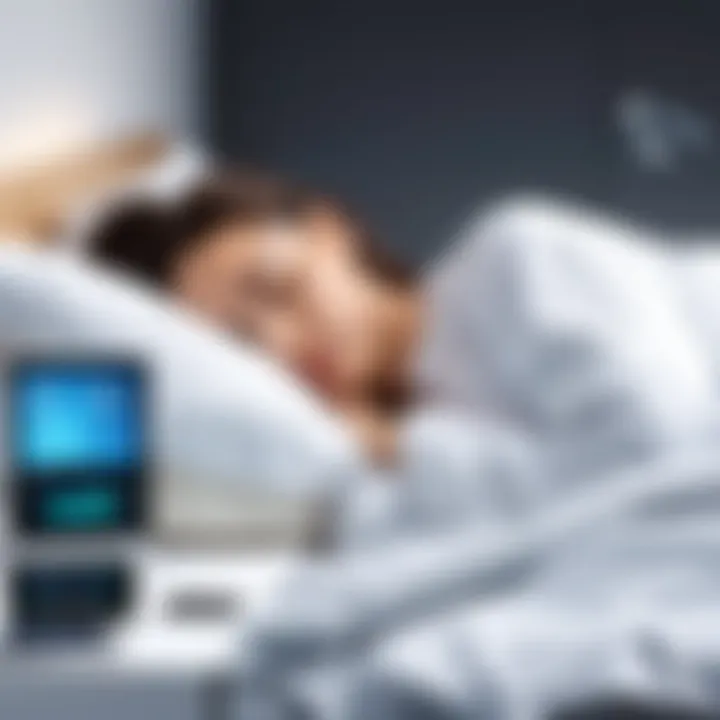Understanding the Stages of the Human Sleep Cycle


Intro
Sleep, a fundamental aspect that shapes our daily lives, often goes unnoticed in its complexity. This article aims to peel back the layers of the human sleep cycle, examining its stages, physiological underpinnings, and the wide array of influences on health and well-being. From the delicate dance of neurotransmitters to the regulation of breathing, each night offers a symphony of processes that are vital to our cognitive and emotional stability.
In this exploration, we will dive into how sleep not only affects our capacity to think and feel but also stands as a critical player in physical health. We will draw attention to circadian rhythms––the body's natural clock––that dictate our sleep patterns, and soon, we'll discuss common sleep disorders, their symptoms, and potential remedies. Understanding these various components of sleep is essential, especially in an age where tech and lifestyle can disrupt our natural cycles.
We will also furnish you with insights on how to enhance sleep quality, paving the way for more invigorating mornings and productive days. So, settle in as we uncover the intricacies behind this often-taken-for-granted aspect of life.
Prelims to Sleep Science
Understanding sleep science is not just a niche interest; it's foundational to knowing how our bodies function. Sleep, an essential biological process, impacts every aspect of our lives—from memory retention to emotional regulation. A clear grasp of sleep science allows individuals to make informed decisions about their health and lifestyle. In a world that often prioritizes productivity over rest, the significance of studying sleep can’t be overstated. It unravels the depths of an often-misunderstood phenomenon that holds the key to enhancing our well-being.
Definition of Sleep
Defining sleep isn't as straightforward as it might seem. Sleep can be described as a reversible state of reduced responsiveness to external stimuli. It is characterized by changes in brain activity, muscle tone, and eye movement. Importantly, sleep isn't merely the absence of wakefulness, rather it consists of various stages that play distinct roles in our bodily functions.
The body cycles through sleep stages, notably categorized into non-rapid eye movement (NREM) and rapid eye movement (REM) sleep. NREM consists of three stages, with the deepest stage facilitating restorative processes. In contrast, REM sleep is where dreams occur and is thought to play a critical role in memory consolidation.
Sleep stages are crucial for overall wellness.
Key Points in Defining Sleep:
- Physiological state: Involves changes in brain activity and body functions.
- Restorative: Essential for physical and mental health by enabling recovery.
- Cyclic: Our sleep follows a pattern that influences how we feel the next day.
"At its core, sleep is an essential pillar of health."
Historical Perspectives on Sleep
Throughout history, sleep has oftentimes been a topic cloaked in mystery and misconception. In ancient civilizations, sleep was seen as a divine or mystical state. The Greeks, for instance, regarded sleep as a gift from the gods, a time when the soul could wander without the constraints of the waking world. Philosophers like Aristotle pondered the nature of sleep, speculating on its significance to human experience.
Fast forward to the 19th century, sleep took on a more scientific approach. Researchers diligently aimed to understand the mechanics of sleep, leading to the establishment of sleep as a distinct area of study. The advent of the electroencephalogram (EEG) in the 1920s was transformative, allowing scientists to observe brain activity during sleep, and thus paving the way for modern sleep medicine.
The 20th century brought an explosion of research into the human sleep cycle. With advancements in technology, scientists are now able to look into sleep disorders, such as apnea or insomnia, with more precision.
Notable Shifts in Understanding Sleep:
- Ancient Beliefs: Sleep viewed as divine; mystical aspects highlighted.
- 19th Century: Rise of experimental approaches to studying sleep cycles.
- Modern Era: Utilization of EEG and other technologies to parse sleep stages and disturbances.
Anatomy of Sleep
The anatomy of sleep is a fascinating realm that intertwines various biological processes essential for our well-being. Understanding how sleep works at a physiological level sheds light on why it is so critical for both our minds and bodies. When we dive into the components that contribute to sleep, we unveil key aspects that benefit our overall health, cognitive functions, and emotional stability. Each element—from brain activity to hormonal balance—plays a crucial role in shaping our sleep cycles. As such, it's vital for our audience, comprising tech-savvy individuals and early adopters of technology, to appreciate the underlying mechanisms that finetune our rest and recovery.
The Brain's Role in Sleep
The brain, the powerhouse of our thoughts and actions, also orchestrates our sleep cycles. During different stages of sleep, the brain exhibits varied electrical patterns that reveal a lot about what is occurring internally. Synchronized neural activity governs the transitions between wakefulness and slumber.
This cycle comprises several stages—each vital for restoring mental and physical health. For instance, during NREM stages, particularly deep sleep, the brain engages in memory consolidation and detoxification processes. On the flip side, REM sleep is the stage where creativity and emotional regulation are most active.
"The brain isn't just resting during sleep; it's busy reinforcing connections and cleaning house."
Key elements in brain activity include:
- Electroencephalogram (EEG) Patterns: The different waveforms observed during sleep provide insight into the quality and type of sleep experienced.
- Neurotransmitters: Chemicals like gamma-aminobutyric acid (GABA) and neurotransmitters such as serotonin influence transitions between sleep stages.
- Circadian Signals: Light exposure and other environmental cues regulate the brain's production of melatonin, ensuring the body knows when it’s time to rest.


In summary, the brain is not merely a passive observer during sleep but an active participant in maintaining and improving health through its complex processes.
Hormones Influencing Sleep
Hormones play a massive role in regulating our sleep patterns, acting as messengers that dictate many physiological changes in the body. Primarily, the interaction between different hormones ensures we experience the right amount of sleep at the right times.
One of the most discussed hormones in sleep science is melatonin. This 'sleep hormone' is produced in response to darkness and promotes the onset of sleep. It helps signal to the body that it’s time to slow down and prepare for the night ahead. However, several other hormones contribute significantly to sleep quality and duration:
- Cortisol: Typically known as the stress hormone, cortisol levels should be low at night. If elevated, they can disrupt sleep cycles.
- Growth Hormone (GH): Released primarily during deep sleep, GH is essential for growth and cell repair.
- Ghrelin and Leptin: These hormones regulate appetite, impacting how we eat and feel, which in turn affects our sleep quality.
Overall, understanding the hormonal interplay involved in sleep can help individuals make informed decisions about lifestyle changes and the use of technology to optimize their sleep environment and habits.
Stages of Sleep
Understanding the stages of sleep is fundamental to grasping the complexities of the human sleep cycle. Each stage plays a unique role in ensuring our physical and mental well-being. In total, there are two major types of sleep: Non-Rapid Eye Movement (NREM) sleep, which encompasses several stages, and Rapid Eye Movement (REM) sleep. These stages not only influence the quality of our rest but also our cognitive functions, emotional balance, and overall health.
NREM sleep is crucial for physical restoration and memory consolidation, while REM sleep contributes significantly to emotional processing. It's almost like a well-tuned orchestra, where each sleep stage harmonizes to produce the symphony of restorative sleep that our bodies so desperately need.
NREM Sleep Explained
Stage One: Light Sleep
Stage One, also known as light sleep, marks the transition from wakefulness to sleep. It lasts for a few minutes and is characterized by gradual muscle relaxation and decreased brain activity. This stage serves an important purpose as it helps the mind shift gears into a state of rest.
The key characteristic of Stage One is its brief nature; it’s quite easy to be awakened from this stage. This is a beneficial aspect, especially for those who might need to respond to their environment intermittently, such as parents with young children or light sleepers. However, one downside is that disruptions during this stage might leave you feeling groggy instead of refreshed.
Stage Two: Sleep Onset
Once you drift into Stage Two, your body initiates mechanisms to further protect you from waking. This phase typically lasts for about 20 minutes and is marked by a decline in heart rate and body temperature. It's during this stage that you become more oblivious to external stimuli.
The unique feature of Stage Two is the presence of sleep spindles—bursts of brain activity that help consolidate memory and learning. The downside, however, is that the longer one remains in Stage Two without progressing to deeper sleep phases, the less restorative the effects may be. Thus, spending adequate time in this stage is critical.
Stage Three: Deep Sleep
Stage Three, or deep sleep, is the gold standard for recovery. This stage represents the most profound sleep, with the slowest brain waves occurring during this time. Your body undergoes tissue growth and repair, and the immune system is bolstered.
The key characteristic is that it's the hardest stage to wake from, which makes it exceptionally restorative. Experiencing enough deep sleep ensures that you wake up feeling rejuvenated, ready to face the day. However, prolonged disturbances in deep sleep can lead to chronic fatigue and overall health decline.
REM Sleep Characteristics
Once you complete the cycle through NREM sleep stages, you transition into REM sleep. This stage is fascinating; it's when most dreaming occurs, and the brain is highly active, almost mimicking the state of wakefulness. Moreover, REM sleep plays a pivotal role in emotional regulation and creativity.
One interesting aspect is that REM stages gradually prolong with each cycle throughout the night. Consequently, achieving balanced amounts of both NREM and REM sleep contributes to a well-rounded sleep experience.
"Sleep is the best meditation."
- The Dalai Lama
It's essential to appreciate that these stages are interconnected, each building upon the previous phases. Given the importance they hold for cognitive functions and emotional health, understanding these stages can offer significant insights into optimizing sleep quality.
Circadian Rhythms
Circadian rhythms are like the internal beat of our bodies, guiding our sleep-wake cycle along with various biological processes over a roughly 24-hour period. These rhythms are linked closely to light and darkness, playing a critical role in determining not just when we sleep but also how well we function throughout the day. In understanding these rhythms, we grasp an essential element of the human sleep cycle—not merely because they dictate our sleep patterns but because they are deeply rooted in our health and well-being.


Understanding the Biological Clock
The biological clock, or circadian clock, is our inner timekeeper. It's not a physical object you can see; rather, it’s a complex network of neurons and hormonal signals that react to environmental cues. The hypothalamus region of the brain, particularly a group of cells known as the suprachiasmatic nucleus (SCN), is our biological clock’s anchor. This area helps synchronize our bodily functions to the day/night cycle, adjusting to factors like light exposure.
What’s fascinating is that even without any direct exposure to light, the biological clock can still perform to some extent. It can maintain a rough 24-hour cycle based on the rhythms we've been accustomed to over time. However, this natural rhythm can be disrupted by factors such as shift work, long-haul flights, or even just staring at screens late into the night.
This disruption can lead to a cascade of effects—from metabolic issues to sleep disorders, and more. It's a web of activity, which keeps the cycle turning.
Impact of Light on Sleep Patterns
Light plays a monumental role in shaping our circadian rhythms. In simple terms, exposure to natural light in the morning helps signal to our body that it’s time to be alert, while dimming light in the evening signals that it’s time to wind down. The hormone melatonin, which helps regulate sleep, is released by the pineal gland in response to darkness. When the light fades, melatonin levels rise, making us feel sleepy. Conversely, exposure to artificial light—especially blue light from gadgets—can trick our brains into thinking it’s still daytime, thus delaying this critical cycling of sleep.
- Things to consider regarding light exposure:
- Morning sunlight can help you wake up more easily and feel invigorated.
- Limit screen time at least an hour before bedtime to ensure your melatonin production isn't hindered.
- Use blackout curtains to keep your sleeping environment dark, optimizing conditions for restful sleep.
"Our bodies are not wired to ignore natural cues. Disregarding our circadian rhythms can lead to more than just feeling tired—it can afflict our mood, cognitive abilities, and even our health long-term."
In our tech-laden existence, understanding the role of light in our lives cannot be overstated. Recognizing its impact enables us to make conscious choices that align with our biological rhythms. Integrating strategies, such as exposure to morning sunlight and the judicious use of artificial lighting, can go a long way in fostering better sleep hygiene and overall wellness.
Importance of Sleep
Sleep is more than just a nightly retreat from the world; it's the foundation upon which our cognitive and emotional lives are built. This article underscores that getting sufficient sleep isn’t merely a luxury but a fundamental necessity for our overall health and well-being. When one thinks about the demands of modern life, especially in a tech-savvy society, sleep becomes even more paramount. Our devices buzz and ping with notifications day and night, and with such constant stimulation, the very essence of restorative sleep is at risk. Yet, the importance of sleep cannot be overstated.
The benefits of adequate sleep extend far beyond feeling well-rested in the morning. Research has illustrated a strong link between sleep quality and various cognitive functions. Memory consolidation, for instance, relies heavily on the different sleep stages. It's during REM sleep that our brains integrate new information and experiences, weaving them into a cohesive tapestry of knowledge that we can draw upon later.
On the flip side, sleep deprivation can lead to a myriad of cognitive impairments, from decreased attention spans to impaired decision-making. Not only does a lack of sleep frazzle our focus, but it can also hinder our creativity and problem-solving abilities. In essence, without proper sleep, our mental agility takes a hit. It's vital for tech enthusiasts and early adopters to grasp that their interaction with technology, while stimulating, might also contribute to sleep disruption.
"Sleep is the golden chain that ties health and our bodies together in a harmonious rhythm."
When it comes to mental health, the importance of sleep is equally significant. Chronic sleep loss can exacerbate existing mental health disorders and may even be a precursor to new ones. Conditions like anxiety and depression can feel more insurmountable when we’re running on empty. Those sleepless nights often turn into a cycle of negative thinking and emotional instability. It’s no surprise that health professionals frequently emphasize the necessity of good sleep hygiene.
In summary, the modern lifestyle challenges our natural sleep rhythms. Understanding the critical role that sleep plays in our cognitive capability and mental well-being can illuminate why we must prioritize it. Ignoring this vital aspect of health can lead to a cascade of negative effects, making it essential to acknowledge sleep not just as a rest period but a vital component of our daily lives.
Common Sleep Disorders
Understanding common sleep disorders is paramount for realizing the full impact of sleep on our lives. These disorders not only hinder the quality of rest but can significantly affect daily functioning, relationships, and overall mental and physical health. Knowing the ins and outs of these conditions can lead individuals to seek appropriate help and implement effective strategies that enhance sleep quality.
Insomnia: Causes and Solutions
Insomnia is a sleep disorder characterized by difficulty falling or staying asleep. It's no walk in the park—many people find themselves tossing and turning, haunted by thoughts that won’t quiet down. Various factors contribute to insomnia, including stress, anxiety, medications, and even lifestyle choices like excessive caffeine or screen time before bed.
Solutions range from cognitive behavioral therapy to simple behavioral adjustments. Practices like sleep journaling can help identify patterns or triggers. Incorporating relaxation techniques, such as deep breathing or gentle stretching before bedtime, can also pave the way for a more peaceful night.
"Sleep is the best meditation." – Dalai Lama
Sleep Apnea Explained
Sleep apnea is a breathing disorder that occurs when breathing repeatedly stops and starts during sleep. This disruption can result in fragmented sleep and day-to-day fatigue, which makes managing daily tasks a challenge. There are two primary types: obstructive sleep apnea, which occurs when throat muscles relax excessively, and central sleep apnea, which happens when the brain fails to signal the muscles to breathe properly.
Diagnosis generally involves a polysomnography test, which records various bodily functions while you sleep. Treatment options vary, but include lifestyle changes, continuous positive airway pressure (CPAP) devices, and even surgical approaches in severe cases.
Restless Leg Syndrome


Restless Leg Syndrome (RLS) is another disruptive sleep disorder, wherein an uncontrollable urge to move one’s legs typically manifests in the evenings. It’s as if your legs demand a dance party when your mind yearns for stillness. Factors contributing to RLS may include iron deficiency, diabetes, and pregnancy, among others.
An individual experiencing RLS can benefit from lifestyle changes, such as stretching and reducing caffeine intake. Furthermore, certain medications may help alleviate symptoms. Keeping a daily diary to track what exacerbates or lessens symptoms can provide valuable insights.
Overall, acknowledging and addressing these common sleep disorders is step one in enhancing sleep quality and, by extension, improving overall health and well-being.
Strategies for Improving Sleep Quality
Getting a good night’s sleep isn’t just about hitting the pillow at the end of a long day. In our fast-paced world, the quality of sleep is often overlooked, leaving many feeling like zombies during the day. Improving sleep quality plays a significant role in our overall health, affecting our cognitive functions, mood, and physical well-being. Good sleep strategies go beyond simple bedtime routines; they encompass the creation of conducive environments, consistent scheduling, and mindfulness practices.
Creating a Sleep-Inducing Environment
To catch those Zzzs, one must consider their surroundings. Your bedroom may be your sanctuary, but if it’s filled with distractions, sleep remains elusive.
- Darkness is Key: Block out all light; it’s time to channel your inner cave dweller. Room-darkening shades can make all the difference, signaling your body that it's time to rest.
- Temperature Control: Cooler is better. Studies suggest that sleeping at around 60 to 67 degrees Fahrenheit can enhance sleep quality. A thermometer can be your best friend here.
- Noise Management: Silence can be golden, but here white noise can be too. Many folks use fans or gentle sound machines to drown out disturbances.
- Comfortable Bedding: A good mattress and supportive pillows are non-negotiables. The investment in quality bedding can lead to uninterrupted sleep for years to come.
Takeaway: Don’t underestimate the power of your surroundings. A sleep-friendly environment might just be your ticket to dreamland.
Establishing a Consistent Sleep Schedule
Your body thrives on predictability. Much like a well-oiled machine, a consistent sleep schedule helps regulate your internal clock.
- Fixed Wake-Up Time: Waking up at the same time every day - yes, even on weekends - can set the tone for your sleep patterns.
- Wind-Down Ritual: Consider incorporating a calming routine before bed that cues your body it's time to sleep. This can be reading, gentle stretches or listening to relaxing music.
- Limit Naps: While it's fine to catch some daytime shut-eye, limit those naps to 30 minutes to avoid interfering with your nightly rest.
"Regular sleep times help in maintaining the quality of sleep and enhancing alertness during waking hours."
A consistent sleep schedule may improve your sleep efficiency and decrease grogginess upon waking. It’s all about giving your body the reliability it craves.
Mindfulness and Relaxation Techniques
In our tech-driven age, stress seems to be an old friend many can’t shake off. Taming that stress through mindfulness and relaxation techniques can be a game-changer for restful sleep.
- Meditation: Incorporating a brief meditation practice, even mere minutes can shift your brain into a more restful state.
- Breathing Exercises: Techniques like the 4-7-8 breathing can calm your nervous system. The method is simple: inhale for four seconds, hold for seven, and exhale for eight. Repeat until you feel your mind clear.
- Gentle Yoga: Stretching can release tension, making it easier to fall asleep. Even a few minutes of gentle movement can relax your muscles significantly.
Combining these practices into your routine doesn't take long. It can offer substantial benefits, paving the way to sound sleep in a chaotic world.
Understanding and implementing these strategies is crucial in enhancing sleep quality. The rewards extend far beyond the night, setting the stage for productivity and health during the day.
The Future of Sleep Research
As our understanding of sleep unfolds, the future of sleep research emerges as a vital domain that promises to reshape how we view and prioritize rest. The evolution of technology and science points towards a greater integration of interdisciplinary approaches to studying sleep. Equipped with advanced diagnostic tools and a growing reservoir of data, researchers are no longer confined to traditional methodologies. Rather, they are embarking on an exciting journey towards unraveling the complexities of sleep and its profound impact on health.
Emerging Technologies in Sleep Studies
The landscape of sleep research is undergoing a transformation due to technology. Innovative devices like wearable sleep trackers and smart mattresses provide a treasure trove of information that can monitor sleep patterns in real-time. These advances enable researchers and individuals alike to gather invaluable insights about sleep quality and patterns. Moreover, artificial intelligence is stepping in, analyzing vast datasets to identify correlations that weren’t possible before.
For example, technologies like polysomnography, which measures brain waves, heart rate, and other physiological parameters, have gotten a significant facelift. Researchers today use portable devices that can be operated in a person’s natural sleep environment, eliminating the need for sleep labs that can often be intimidating and artificial. This new method is making it far easier for individuals to partake in studies from the comfort of their own beds.
- Wearable technology: Devices capable of tracking your heart rate, movement, and sleep stages, like the Oura Ring or Fitbit.
- AI-driven analysis: Machine learning algorithms that detect trends and predict sleep disorders.
- Smart home integration: Systems that optimize the bedroom environment, adjusting lighting and temperature automatically for ideal sleeping conditions.
Potential Discoveries and Implications
The implications of this burgeoning field are both extensive and significant. As researchers harness data and technology, potential discoveries could revolutionize not just how we understand sleep, but how we treat sleep-related ailments. Imagine finding treatments based not solely on subjective experiences of sleep issues but on accurate data and predictive analytics.
For example, insights gained from sleep studies can lead to more personalized solutions for conditions such as insomnia or sleep apnea. This personalized approach not only has the potential to enhance sleep quality but may also alleviate related health problems, such as mental health disorders and cognitive decline.
Furthermore, understanding the genetic and environmental factors affecting sleep might unlock answers to why certain individuals experience sleep disturbances while others don’t. This could shift the focus of treatment from merely addressing symptoms to targeting the underlying causes, leading to better outcomes for many.
"In the coming years, the synergy between research and technology is likely to unveil new frontiers of understanding about sleep—far beyond what we know today."
The future of sleep research promises to be a rich field of exploration, revealing not just how we sleep, but why it matters profoundly for our overall health. As technologies evolve and our understanding deepens, we may very well find ourselves on the verge of solutions that could transform the quality of life for millions.







